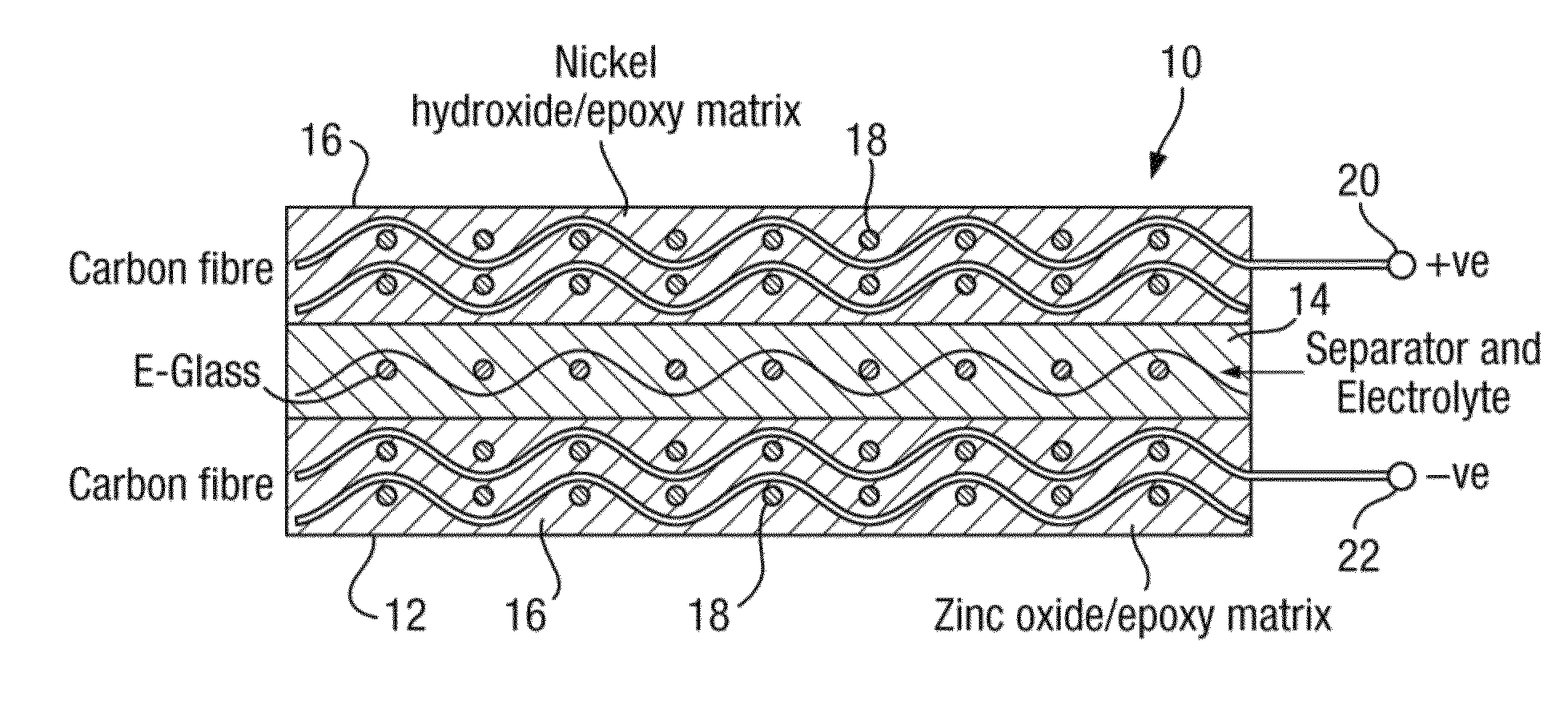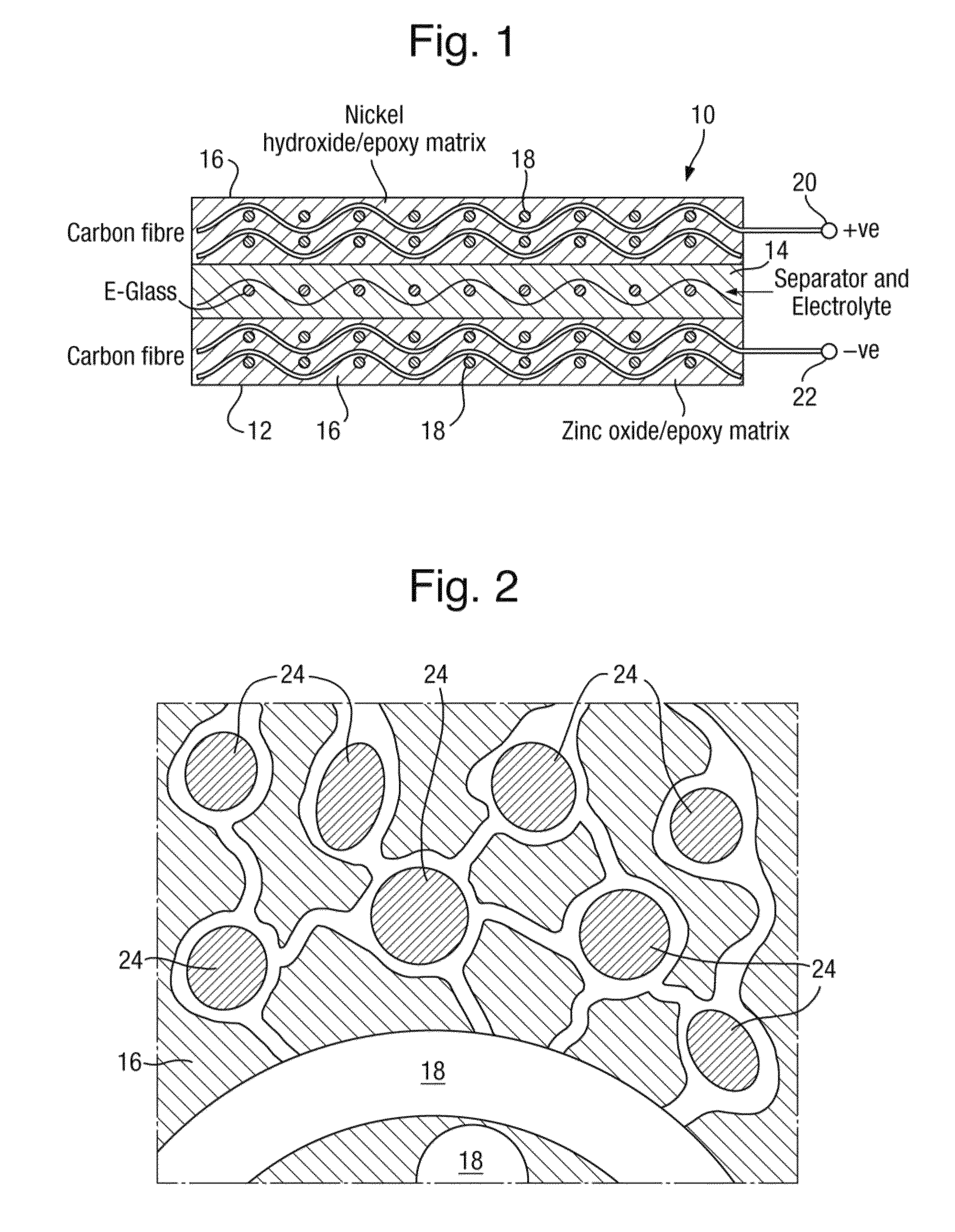Rechargeable batteries
a rechargeable battery technology, applied in the field of rechargeable batteries, can solve the problems of low utilisation, and achieve the effect of increasing the utilisation of active materials in anodes and cathodes, and increasing battery gravimetric or volumetric efficiency
- Summary
- Abstract
- Description
- Claims
- Application Information
AI Technical Summary
Benefits of technology
Problems solved by technology
Method used
Image
Examples
example 1
[0029]In this Example suitable matrix materials were prepared for impregnating a glass fibre sheet material in order to provide a separator structure for a battery, using different porogen:epoxy ratios to provide different levels of porosity. 4.1 g of Struers EpoFix was mixed with 0.5 g EpoFix hardener and a measured mass of PEG200 was added as a porogen. The materials were spread onto a non-stick film and cured for 12 hours at 60° C. Once cured, sample sections of the films were cut to size and soaked in water overnight to dissolve the porogen. The films were then oven dried at 60° C. for 2 hours. The change in mass was used to determine the average porosity with different mass ratios of PEG to epoxy. The results are given in the table below.
[0030]
Mass ratio PEG200:EPOXYAverage Porosity %1:1222:1383:160
[0031]Thus a separator structure may be made by mixing Struers EpoFix resin suitably loaded with PEG200 and impregnating 200 gsm E-glass fabric with the mixture, allowing the materia...
example 2
[0034]In this Example, the effect of the order of mixing the materials was assessed.
[0035]Electrode pastes were made up from the following ingredients:
[0036]4.1 g Struers Epofix resin, 0.5 g of EpoFix hardener, 0.35 g of carbon powder, 3 g of electrochemically active material (Ni(OH)2 or ZnO) of mean particle size between 5 μm and 10 μm, and 12.3 g of PEG200.
[0037]For the first set of electrodes the dry ingredients were mixed with the epoxy resin and then the PEG was added, whilst for the second set the dry ingredients were mixed with the PEG first and then the epoxy was added. Equal masses of epoxy pastes were used to from composite electrodes on plain weave 200 gsm carbon fibre fabrics. The electrodes were cured and soaked to remove the residual PEG. They were then assembled into cells and filled with electrolyte (40% KOH solution saturated with approximately 50 g / l of ZnO added). Capacity tests were made and the energy density for the epoxy-first sample was measured as 0.28 Wh / kg...
example 3
[0041]In order to make up a rechargeable battery first and second porous electrode layers are prepared by making up a respective first and second matrix material epoxy mixtures by one or more of the methods described above and applying them to impregnate layers of conducting carbon fibre reinforcing layers. A porous separator layer is then made by one or more of the methods described above. The various layers may then be partially cured before assembling the electrode:separator:electrode structure to reduce moving or mixing of the ingredients, or they may be assembled in their uncured states. After curing the porogen is flushed out with, for example, warm water and the structure allowed to dry. Electrolyte is then introduced into the cell by vacuum and / or high pressure and / or by simple immersion to induce a capillary action. On particular samples, fill or drain points may be formed in the cell to provide leakproof access through one of the electrode layers. The electrolyte again may...
PUM
| Property | Measurement | Unit |
|---|---|---|
| mass | aaaaa | aaaaa |
| mass | aaaaa | aaaaa |
| energy density | aaaaa | aaaaa |
Abstract
Description
Claims
Application Information
 Login to View More
Login to View More - R&D
- Intellectual Property
- Life Sciences
- Materials
- Tech Scout
- Unparalleled Data Quality
- Higher Quality Content
- 60% Fewer Hallucinations
Browse by: Latest US Patents, China's latest patents, Technical Efficacy Thesaurus, Application Domain, Technology Topic, Popular Technical Reports.
© 2025 PatSnap. All rights reserved.Legal|Privacy policy|Modern Slavery Act Transparency Statement|Sitemap|About US| Contact US: help@patsnap.com



